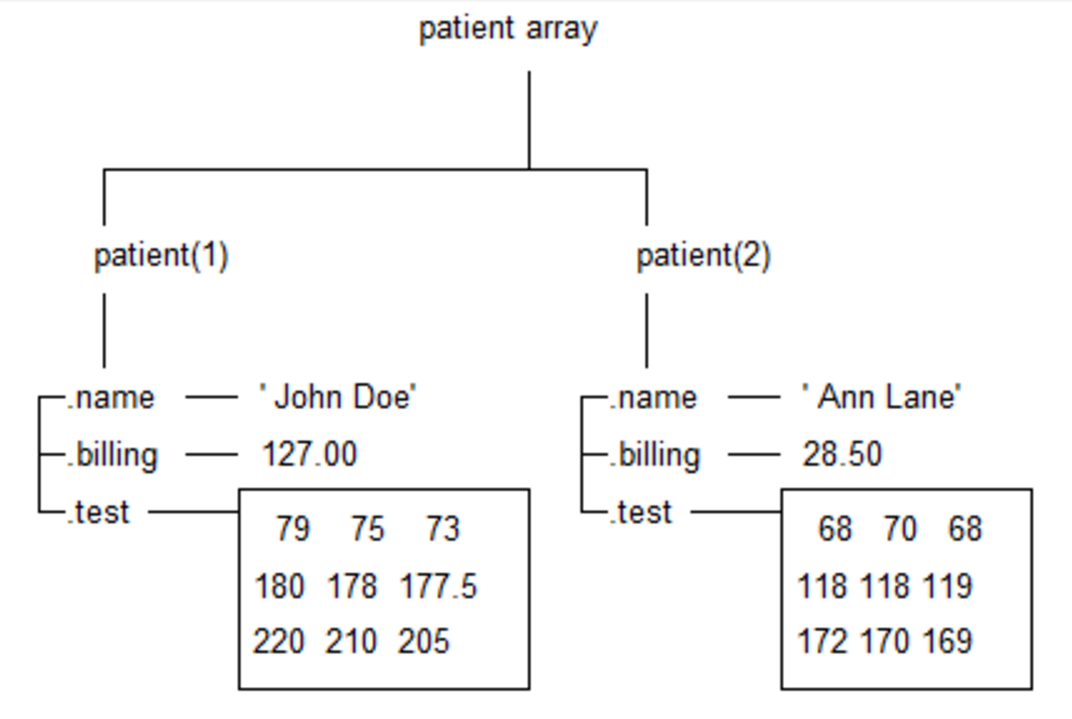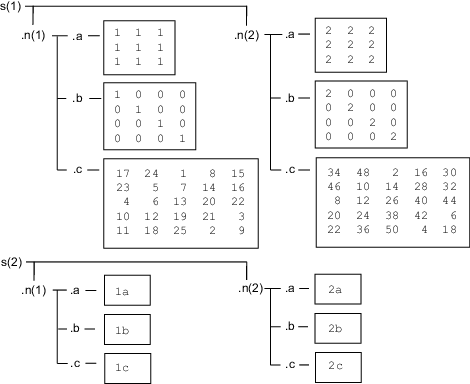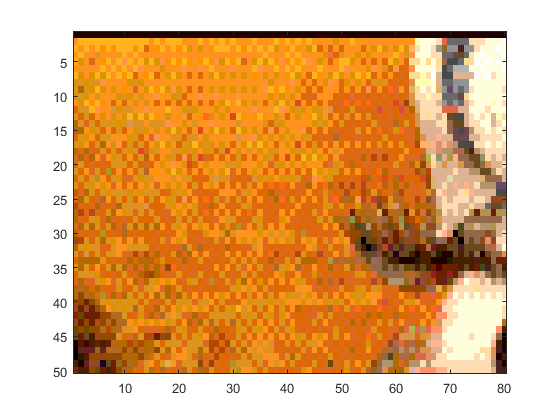Structure Definition


Explicit Structure Declaration

struct...not strut

|
a = struct('b', 0, 'c', 'test') b = a.b c = a.c |
no data
|
Ball = struct('mass',{},'position',{},'velocity',{},'radius',{}); |
with data
|
BALL(1) = struct('mass',10,... 'position',[0 0 100],... 'velocity',[0 0 0],... 'radius', 3); |
example
|
stocks=struct('name',{'GOOG','AAPL'},'full',... {'Google Inc.','Apple Inc'},... 'value',{522.35,278.64},'quant',200) stocks(2).full |
Implicit Structure Declaration

.
|
data.x = linspace(0,2*pi); data.y = sin(data.x); data data.x data.y |
|
patient(1).name = 'John Doe'; patient(1).billing = 127.00; patient(1).test = [79, 75, 73; 180, 178, 177.5; 220, 210, 205]; patient |

|
patient(2).name = 'Ann Lane'; patient(2).billing = 28.50; patient(2).test = [68, 70, 68; 118, 118, 119; 172, 170, 169]; patient |
|
patient(3).name = 'New Name'; patient(3) |
Extract Data from Structure
| amount_due = patient(1).billing |
Plot Structure Data
|
bar(patient(1).test) title(['Test Results for ', patient(1).name]) 
|
Build from Outside-in

|
people(1).name = 'john'; people(1).job = 'manager'; people(1).id = 123456; people(2).name = 'mary'; people(2).job = 'owner'; people(2).id = 567890; people(3).name = 'justin'; people(3).job = 'singer'; people(3).id = 246801; people(1).name people(2).name people(3).name people(:).name a = people(:).name a = [people(:).name] |
|
ball.mass = 10; ball.position = [0, 0, 100]; ball.velocity = [0, 0, 0] ball.position = ball.position + [0 10 0] ball.radius = 3 ball(2:3,1)=ball ball(1).mass = 1.0 ball(2).mass = 5.0 ball(3).mass = 10.0 ball.mass m = [ball.mass] totalMass = sum([ball.mass]) |
Build from Inside-out

|
NameData.First = 'John'; NameData.MI = 'J'; NameData.Last = 'Doe'; |
Assign to higher level element
| StudentData.Name = NameData; |
Create additional fields
|
StudentData.Status = 'Brilliant'; StudentData.HW = 10; StudentData.Exam = linspace(100,100,3); |
View Structure
|
StudentData StudentData.Name StudentData.Exam |
Edit Structure Elements
|
StudentData.Exam(3) = 0; StudentData.Exam StudentData.Name.First = 'Jane'; StudentData.Name |
Arrays of Structures

|
num_students = 5; for i=1:num_students ClassData(i) = StudentData; end ClassData ClassData(2) |
Structures in Functions

|
message = pass_or_fail(ClassData(2)); message |
pass_or_fail.m
|
function message = pass_or_fail(StudentData) Exam_avg = mean(StudentData.Exam); if Exam_avg >= 70 message = 'You pass!'; else message = 'You fail!'; end return; |
Nested Structures
Syntax
| structName(index).nestedStructName(index).fieldName(indices) |

|
|
s(1).n(2).a = 2*ones(3); s(1).n(2).b = 2*eye(4); s(1).n(2).c = 2*magic(5); s(2).n(1).a = '1a'; s(2).n(2).a = '2a'; s(2).n(1).b = '1b'; s(2).n(2).b = '2b'; s(2).n(1).c = '1c'; s(2).n(2).c = '2c'; |
Access Data in a Structure Array
|
S = load('clown.mat') image(S.X) colormap(S.map) |

|
upperLeft = S.X(1:50,1:80); image(upperLeft); |

Structure Tools
isfield

|
if isfield(s,'field3') s.field3 else 'no field3 found' end |
fieldnames()
| fieldnames(s) |
Algorism and Bushism of the Day
 |
 |
|
"I frankly felt like the reception we received on the way in from the airport was very warm and hospitable. And I want to thank the Canadian people who came out to wave -- with all five fingers -- for their hospitality." |
"It's a wise father who knows his child"
|
Lesson of the Day
Formal education will make you a living; self-education will make you a fortune.
If you don't design your own life plan, chances are you'll fall into someone else's plan. And guess what they have planned for you? Not much.
How long are you going to wait before you demand the best for yourself?
"Is the noise in my head bothering you?"
The monologue that runs in our brain is loud. It's heavy-metal loud compared to the quiet signals we get from the rest of the world.
All day, every day, that noise keeps going. It's the only voice that has seen everything we've seen, believes everything we believe. It's the noise that not only criticizes every action of every other person who disagrees with us, but it criticizes their motives as well. And, if we question it, it criticizes us as well.
Is it any wonder that projection is more powerful than empathy?
When we meet people, we either celebrate when they agree with us or plot to change or ignore them when they don't. There's not a lot of room for, "they might have a different experience of this moment than I do."
That noise in our head is selfish, afraid and angry. That noise is self-satisfied, self-important and certain. That noise pushes intimacy away and will do anything it can to degrade those that might challenge us.
But, against all odds, empathy is possible.
It's possible to amplify those too-quiet signals that others send us and to practice imagining, even for a moment, what it might be like to have their noise instead of our noise.
If we put in the effort and devote the time to practice this skill, we can get better at it. We merely have to begin.
Word of the day
Firestarter





